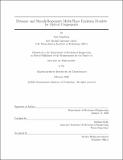| dc.contributor.advisor | Mathias Kolle. | en_US |
| dc.contributor.author | Nagelberg, Sara(Sara Nicole) | en_US |
| dc.contributor.other | Massachusetts Institute of Technology. Department of Mechanical Engineering. | en_US |
| dc.date.accessioned | 2020-09-25T20:03:33Z | |
| dc.date.available | 2020-09-25T20:03:33Z | |
| dc.date.copyright | 2020 | en_US |
| dc.date.issued | 2020 | en_US |
| dc.identifier.uri | https://hdl.handle.net/1721.1/127708 | |
| dc.description | This electronic version was submitted by the student author. The certified thesis is available in the Institute Archives and Special Collections. | en_US |
| dc.description | Thesis: Ph. D., Massachusetts Institute of Technology, Department of Mechanical Engineering, 2020 | en_US |
| dc.description | Cataloged from student-submitted PDF of thesis. | en_US |
| dc.description | Includes bibliographical references (pages 136-143). | en_US |
| dc.description.abstract | Dynamic micro-optical components have revolutionized imaging, sensing, and display technologies. Multi-phase emulsions are micro-scale droplets formed from multiple immiscible material components suspended in a fluid medium. An interesting aspect of these droplets is that by tailoring the chemistry of the surrounding medium it is possible to control the droplet morphology or to render the droplets responsive to stimuli in the environment, including light, heat, specific molecules, or even bacteria. This thesis explores the optical characteristics of multi-phase droplets, including their refractive, emissive, and reflective properties. This work focuses predominantly on bi-phase droplets formed from two immiscible oils in water, which form double emulsions or Janus droplets. As tunable refractive components, these droplets form dynamic compound micro-lenses with adjustable focal length that is continuously variable from converging lenses to diverging lenses. | en_US |
| dc.description.abstract | Macroscopically these refractive droplets can appear nearly transparent or strongly scattering, depending on their configurations. When a fluorescent dye is dispersed within the higher refractive index phase, a portion of the light emitted will undergo total internal reflection. This results in a strong morphology-dependent angular emission profile, which can be used in molecular sensing for chemicals or pathogens. In reflection, the droplets produce striking iridescent colors. This is due to the interference light being totally internally reflected at the internal interface along distinct optical paths, leading to color. These optical characteristics are analyzed both experimentally and theoretically. Finite Difference Time Domain simulations were used to model wave-optical effects and phenomena that could be treated using geometrical optics were calculated using a custom-built ray tracing algorithm. | en_US |
| dc.description.abstract | Additionally, a theoretical model was developed to explain the iridescent colors, under a geometric approximation that takes into account interference effects. Experimentally the droplets were characterized using several different custom-built microscope setups. Beyond the optical characteristics, we used these setups to investigate the effects of thermal Marangoni flows within the droplets, which cause the droplets to re-orient towards a heat source. This work sets the foundation of understanding the refractive, reflective, and emissive properties of multi-phase droplets, which could form the basis of dynamically controllable or stimuli-responsive micro-scale optical components. | en_US |
| dc.description.statementofresponsibility | by Sara Nagelberg. | en_US |
| dc.format.extent | 143 pages | en_US |
| dc.language.iso | eng | en_US |
| dc.publisher | Massachusetts Institute of Technology | en_US |
| dc.rights | MIT theses may be protected by copyright. Please reuse MIT thesis content according to the MIT Libraries Permissions Policy, which is available through the URL provided. | en_US |
| dc.rights.uri | http://dspace.mit.edu/handle/1721.1/7582 | en_US |
| dc.subject | Mechanical Engineering. | en_US |
| dc.title | Dynamic and stimuli-responsive multi-phase emulsion droplets for optical components | en_US |
| dc.type | Thesis | en_US |
| dc.description.degree | Ph. D. | en_US |
| dc.contributor.department | Massachusetts Institute of Technology. Department of Mechanical Engineering | en_US |
| dc.identifier.oclc | 1196833416 | en_US |
| dc.description.collection | Ph.D. Massachusetts Institute of Technology, Department of Mechanical Engineering | en_US |
| dspace.imported | 2020-09-25T20:03:33Z | en_US |
| mit.thesis.degree | Doctoral | en_US |
| mit.thesis.department | MechE | en_US |
